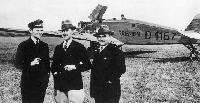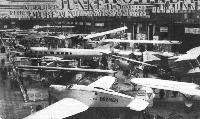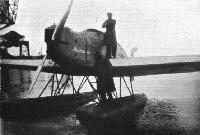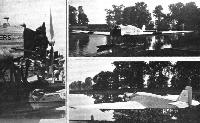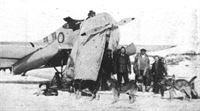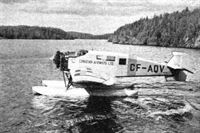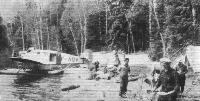
W 33 / W 34 / Ju.46
Легкий транспортный и учебный самолет. Одномоторный цельнометаллический моноплан с неубирающимся шасси. Военный вариант пассажирской машины, созданной в КБ фирмы "Юнкерс флюгцойг унд моторенверке" под руководством Г. Польманна. Первый опытный образец W 34а был поплавковым, он поднялся в воздух в 1926 г. Серийное производство гражданских W 34 начали в 1927 г. Их строили заводы "Юнкерс" в Дессау и "АБ Флигиндустри" в Лимхамне (Швеция). С 1933 г. в Германии стали выпускать и военные W 34h. Всего изготовили 1791 экз. (военных и гражданских).
Экипаж - 2 чел. плюс 6 пассажиров (транспортный вариант), 4 чел. (учебный вариант). Мотор - в зависимости от модификации. Вооружение 1x7,9, бомбы до 100 кг - только на учебных машинах. W 34h состоял на вооружении в Германии с 1933 г., а в находившихся под контролем немцев Словакии и Хорватии - с 1942 г.
Выпускались три военных варианта:
- W 34he с мотором BMW 132A-1;
- W 34hi с мотором BMW 132E-1;
- W 34hau с мотором Bramo 322H.
"Юнкерсы" служили в летных школах, готовивших экипажи для бомбардировочной авиации, а также применялись для перевозки пассажиров и грузов на небольшие расстояния. К началу Второй мировой войны они уже устарели, но продолжали применяться как транспортные, в основном в тылу.
Словацкие W 34h приняли участие в национальном восстании в 1944 г. Хорватские ВВС применяли их против партизан Югославии. Трофейные машины с 1944 г. эксплуатировались в СССР гражданской авиацией и ВВС, позднее также авиацией МВД. Производство W 34 прекратили в Дессау в 1934 г.
W34he||
Размах:||18,48 м
Длина:||10,27 м
Моторы, количество х мощность:||1x660 л.с.
Взлетная масса, максимальная:||3200 кг
Максимальная скорость:||265 км/ч
Практический потолок:||6300 м
Дальность:||900 км
Описание:
- W 33 / W 34 / Ju.46
- Junkers W 33, W 34 и K 43
- Junkers Ju 46
- Flight, July 1926
THE GERMAN SEAPLANE COMPETITION
Фотографии
-
Мировая Авиация 162
Регистрационный номер: CF-AQB Семейство самолетов W 33/34, созданное на базе знаменитой машины F 13, сохранило высокую надежность своего предшественника. Эти самолеты пользовались популярностью в Канаде, полностью отвечая суровым условиям эксплуатации в этой стране. На рисунке представлен вариант с поплавковым шасси.
-
Aviation Historian 15 / J.Stroud - The Finnish Line /The John Stroud Archive/
Регистрационный номер: OH-MVI [6], JU-127 [6] The K 43 wore a simple two-tone green camouflage colour scheme with bare-metal undersides while in service with the Finnish Coast Guard.
-
Air International 1984-10 / ??? - Colombia's Air Arm
This Junkers W 34, one of nine acquired in 1932 and shared with SCADTA, is preserved in the Museo Aeronautico at Bogota.
-
Aeroplane Monthly 1987-07 / J.Stroud - Wings of Peace
Регистрационный номер: D-921 [2] D-921, the prototype Junkers W 33, was converted from an F 13.
-
Aeroplane Monthly 1987-07 / J.Stroud - Wings of Peace
Регистрационный номер: D-1167 [4] The W 33 D-1167 Bremen which made the first east-west aeroplane crossing of the North Atlantic. It was given upturned wingtips before the flight.
THE GERMAN ATLANTIC FLIGHT: Three-quarter front view of the Junkers W.33 monoplane "Bremen," with 280-310 h.p. Junkers L.5 engine, in which Capt. Koehl, Baron von Huenefeld and Commandant Fitzmaurice flew from Baldonnel to Greenly Island, off Labrador. -
Flight 1930-07 / Flight
The Junkers W.33 monoplane (Junkers engine) owned by Walcot Air Line, Ltd.
-
Авиация и Космонавтика 2007-04 / Знаменательные даты весны 2007г. в области авиации
Регистрационный номер: R-RDAJ -
Flight 1928-05 / Flight
Регистрационный номер: D-1167 [4] THE GERMAN-IRISH ATLANTIC FLIGHT: The Junkers monoplane, "Bremen," on the rocky and snow-covered Greenly Island, where Baron von Huenefeld, Capt. Koehl, and Maj. Fitzmaurice landed on April 13, after their 37-hour flight across the Atlantic.
-
Flight 1928-04 / Flight
Регистрационный номер: D-1167 [4] THE GERMAN ATLANTIC FLIGHT: Filling up the "Bremen" with fuel 45-hour flight.
-
Мировая Авиация 82
Регистрационный номер: D-1167 [4] 12-13 апреля 1928г.: бывший шеф-пилот авиакомпании "Luft Hansa", специалист по ночным полетам Герман Куль (справа), с майором ирландских ВВС Фицморисом (в центре) и бароном фон Хюнефельдом (слева) на самолете Junkers W 33 Bremen без посадки перелетели через Северную Атлантику с востока на запад.
-
Flight 1928-10 / Flight
An Historic Exhibit. The Junkers W33 "Bremen," which made the first east to west Atlantic flight.
-
Flight 1928-07 / Flight
IN THE GRAND PALAIS: View looking North. In the foreground the Junkers W.33 type, "Bremen." Some distance behind that the large Farman passenger carrier.
Другие самолёты на фотографии: Farman F.180 Oiseau Bleu - Франция - 1928
-
Air Enthusiast 1998-09 / J.Grant - Corrugated Masterpieces
Регистрационный номер: D-1925 [3] Bertram and Hausmann’s W.33 D-1925 being worked on at Maylands, Perth, Western Australia, following its conversion to landplane later in September 1932.
-
Air Enthusiast 1998-09 / J.Grant - Corrugated Masterpieces
Регистрационный номер: D-1925 [3] ABC’s replica of D-1925 at Broome during filming of the mini-series ‘Flight into Hell’.
-
Aeroplane Monthly 1984-12 / P.Jarrett - Grapevine
Регистрационный номер: D-1925 [3] The Junkers-W 33c D-1925 Atlantis is a non-flying replica built in 3 1/2 months at a cost of about $150,000 for an Australian TV documentary dramatisation. A 260 h.p. Daimler-Jaguar car engine enables it to taxy at 20kt.
-
Aeroplane Monthly 1987-07 / J.Stroud - Wings of Peace
Регистрационный номер: D-1696 Luft Hansa’s W 33c D-1696 Taurus. The dark rectangle on the fuselage, forward of the door, is a panel on the base of which are the words London-Berlin.
-
Aeroplane Monthly 1976-05 / H.Seabrook-Smith - Lufthansa 1926-76 (2)
Регистрационный номер: D-2009 The Junkers W.33 first appeared in 1926 and was developed directly from the F.13. The example shown is W.33f D-2009 Bosporus.
-
Авиация и Космонавтика 1999-04 / А.Демин - Ода героям-летчикам, ездовым собакам и чрезвычайным тройкам
ПС-4 И.Доронина в ледовом лагере
-
Авиация и Космонавтика 1999-04 / А.Демин - Ода героям-летчикам, ездовым собакам и чрезвычайным тройкам
Ремонт шасси ПС-4 И.Доронина на льдине
-
Авиация и Космонавтика 1999-04 / А.Демин - Ода героям-летчикам, ездовым собакам и чрезвычайным тройкам
"Вся действующая авиация Чукотки" на аэродроме в Ванкареме (слева направо): три Р-5, Ш-2 Бабушкина, ПС-4 Доронина
Другие самолёты на фотографии: Поликарпов Р-5 - Россия - 1928Шавров Ш-2 - Россия - 1930
-
Авиация и Время 2007-03 / М.Маслов - Первый в своем роде
Четверка Г-1 Полярной авиации на речном ледовом аэродроме в одном строю с У-2 и "Юнкерсом" B-33
Другие самолёты на фотографии: Поликарпов У-2 / По-2 - Россия - 1928Туполев ТБ-1 / АНТ-4 - Россия - 1925
-
Aeroplane Monthly 1987-07 / J.Stroud - Wings of Peace
Регистрационный номер: D-1642 W 33c D-1642 demonstrating crop spraying.
-
Air Enthusiast 2000-11 / L.Andersson - Iranian Eagles
Iran acquired two Junkers W.33s in 1929. This one has the serial number '35' under its wings.
-
Air Enthusiast 2000-11 / L.Andersson - Iranian Eagles
Junkers W.33 after repaint, bearing the serial number 'J7'.
-
Air Enthusiast 2000-11 / L.Andersson - Iranian Eagles
Persian ground crew handling bombs on front of a Junkers W.33.
-
Air Enthusiast 2000-11 / L.Andersson - Iranian Eagles
Регистрационный номер: D-1684 Junkers W.33 D-1684 'Gomri' of Junkers-Luftverkehr. One can only ponder over what the man with the stick is doing!
-
Air Enthusiast 2003-05 / L.Andersson - Turbulent origins
The delivery of a pair of Junkers W 33s was stopped before the aircraft reached Afghanistan. One of them is seen here prior to the delivery flight. It has the black Afghan national flag on the wings.
-
Aeroplane Monthly 1991-07 / T.Gwynn-Jones - Flying for gold (2)
Ray Parer (on wing) and his brother Kevin pose with porters by Junkers-W 33 The Lady Lettie.
-
Air-Britain Archive 1986-02
The Ethiopian Junkers W 33c at Dessie after its repair but before the name and lion were applied.
-
Air-Britain Archive 1986-02
Later, at Jan Meda, the Junkers fully painted and with national colours on the rudder and in rectangular 'flags' on the wings.
-
Aeroplane Monthly 1996-08 / T.Gwynn-Jones - A matter of honour
Регистрационный номер: J-BFUB In 1932 this Junkers-W 33, No 3 Hochi Nichi-Bei, commanded by Eiichiro Baba, vanished over the Pacific after radio contact was lost six hours after take-off.
-
Air Enthusiast 1994-09 / L.Andersson - Chinese 'Junks'
Eurasia’s first aircraft, Junkers W 33 EURASIA I (c/n 2545), takes-off from Lanchow in 1931 or 1932.
-
Air Enthusiast 1994-09 / L.Andersson - Chinese 'Junks'
The first of Feng Yu-hsiang’s Junkers W 33s at Shanghai prior to the delivery flight to Loyang, Honan in May 1929. General Chang, Feng’s representative in Shanghai, is in the centre.
-
Air Enthusiast 1994-09 / L.Andersson - Chinese 'Junks'
Military Junkers W 33 at Nanking, 15 June, 1931. This is probably one of the two W 33s ordered by but not delivered to Honan.
-
Air Enthusiast 1998-09 / J.Grant - Corrugated Masterpieces
An unknown Australian W.34 on floats.
-
Flight 1931-05 / Flight
CAPT. AHRENBERG: Our illustration shows Capt. J .Ahrenberg (on float) and his wireless operator, Ljunglund, just before setting out from Malmo for Greenland in the Junkers seaplane to take part in the rescue of Mr. Courtauld. Shell spirit and oil were used for this flight, which rendered material assistance in the rescue work.
-
Aeroplane Monthly 1987-07 / J.Stroud - Wings of Peace
Unidentified Swedish W 33g ambulance floatplane.
-
Air Enthusiast 2000-11 / L.Andersson - Iranian Eagles
Регистрационный номер: D-921 [2] An interesting view from the Junkers repair workshops in Tehran. To the left is a wing from Junkers-Luftverkehr's W.33 D921 and in the middle is an A.20 wing with the red-white-green roundel and a marking that looks like 'I-P' or possibly 'd-I'.
Другие самолёты на фотографии: Junkers A 20 / A 35 / K 53 - Германия - 1923
-
Aeroplane Monthly 1987-07 / J.Stroud - Wings of Peace
Регистрационный номер: SE-ABZ [2] AB Aerotransport's W 33 SE-ABZ after being fitted with a Pratt & Whitney Wasp engine, making it one of the few radial-engined W 33s.
-
Flight 1926-07 / Flight
JUNKERS AT WARNEMUNDE: The machine shown in the lower right-hand corner is the type W.33, which has a 300 h.p. Junkers L.5 engine. Above is a photograph of the type W.34, similar to the W.33 except that it has a Bristol "Jupiter" engine. On the left is shown the nose of the W.34, illustrating the mounting of the "Jupiter." Note the Reed metal airscrew.
-
Aeroplane Monthly 1987-07 / J.Stroud - Wings of Peace
Регистрационный номер: D-922 The prototype Junkers W 34. The circular roof hatch is just visible.
-
Aeroplane Monthly 1997-06 / H.Amtmann - My Junkers years
Регистрационный номер: G-AUGZ [2] The Junkers-W 34 with a Bristol Jupiter VII supercharged engine and Hele-Shaw/Beacham variable-pitch propeller in which Neuenhofen set a world altitude record of 41,740ft on May 26, 1929.
W 34b c/n 2601 had a Bristol Jupiter engine and went to Guinea Airways as G-AUGZ. -
Flight 1928-05 / Flight
Регистрационный номер: G-AUGZ [2] A "Jupiter" Engined Junkers for New Guinea. An Australian company, the New Guinea Gold Co., which is at present prospecting for gold in New Guinea, has acquired a Junkers W-34 monoplane, fitted with a Bristol ''Jupiter'' engine for the work. The mining area is situated 65 miles from the coast at an altitude of 10,000 ft. and owing to the difficult nature of the country a round trip to and from the mine area takes about three weeks by ordinary methods! The air trip takes about one hour. There is no possible landing place between the two aerodromes, so engine reliability is essential - hence the "Jupiter." (Note. - Our pictures were not taken in New Guinea!)
-
Flight 1929-06 / Flight
Herr Neuenhofen (right), who reached an altitude of 41,740 ft. on May 26 in the Junkers "Bremen" low-wing monoplane fitted with Bristol "Jupiter" engine, by which he is standing, with his two Junkers engineers, Herr Thiedemann (centre) and Herr Schinzinger, who were responsible for the technical preparations. Subject to official confirmation, this altitude figure is a world's record.
-
Aeroplane Monthly 1991-07 / T.Gwynn-Jones - Flying for gold (2)
Pilot and passenger in the cockpit of one of the five Junkers-W 34s operated by Guinea Airways.
-
Air Enthusiast 1998-09 / J.Grant - Corrugated Masterpieces
Регистрационный номер: VH-UOX [2] Guinea Airways No.5, W.34f VH-UOX, in cargo configuration.
-
Aeroplane Monthly 1978-12 / Personal album
Регистрационный номер: VH-UOX [2] This Guinea Airways Junkers W34, VH-UOX, ground-looped at Slate Creek, New Guinea, in 1937, owing to a tail wind, ending up in the creek; hence the makeshift “undercarriage”.
-
Air Enthusiast 1998-09 / J.Grant - Corrugated Masterpieces
Регистрационный номер: VH-UNM [3] Guinea Airways No.3, W.34d VH-UNM being prepared for flight.
-
Flight 1938-04 / Flight
In South America: A Sedta Junkers leaving Quito for Guayaquil. The company was started by Herr Hammer, one of the pioneers of South American air transport.
-
Flight 1939-04 / Flight
A Canadian Airways Junkers W.34 at Fort Chipewyan, with local inhabitants and a dog team to take the mail and freight from the machine to the settlement. Note the tarpaulin cover on the engine and the two canoes lashed to the underside of the wings.
-
Flight 1938-07 / Flight
IN ECUADOR: A Junkers Ju. 34 (540 h.p. B.M.W. Hornet) and (nearest camera) Messerschmitt Taifun, of Sedata, Ecuador’s airline. It is seen on Quito Aerodrome, which is surrounded by mountains, and difficult to approach in bad weather (the company was recently unlucky enough to lose its founder, Herr Fritz Hammer, when the clouds closed down on a machine which he was flying out of Quito). In spite of such difficulties, the line gives valuable service, notably by reducing the time from Quito to Guayaquil to hours as compared with a two-day train journey.
Другие самолёты на фотографии: Messerschmitt Bf.108 Taifun - Германия - 1934
-
Aeroplane Monthly 1991-07 / T.Gwynn-Jones - Flying for gold (2)
Part of the Guinea Airways fleet at Lae in 1932. In addition to the Junkers-G 31s, a pair of W 34 monoplanes and three D.H.60 Moths are on display.
Другие самолёты на фотографии: De Havilland Gipsy Moth / Moth X - Великобритания - 1928Junkers G 31 - Германия - 1926
-
Flight 1930-01 / Flight
FLYING FOR NEW GUINEA GOLD: Two views of a Junkers W.34 (Bristol "Jupiter") monoplane of Guinea Airways, Ltd. On the right, arriving at Lae as a seaplane. On the left, unloading the monoplane (now a landplane).
-
Aeroplane Monthly 1978-12 / Personal album
Регистрационный номер: VH-UNM [3] Junkers W34 VH-UNM of Guinea Airways at Port Moresby, Papua, in 1939. Mr Cannon recalls 8 that these machines, powered with 500 h.p. Pratt & Whitney radials, were “terrific”, and could carry a one-ton pay load as landplanes or 1,600lb as floatplanes.
-
Aeroplane Monthly 1978-12 / Personal album
Регистрационный номер: VH-UNM [3] Another shot of Junkers W34 VH-UNM at Port Moresby in 1939.
-
Aeroplane Monthly 1987-07 / J.Stroud - Wings of Peace
SCADTA’s W 34 floatplane Cundinamarca on the Magdalena river. A second W 34 is in the background.
-
Flight 1939-06 / Flight
Регистрационный номер: CF-AQV [2] FLOATS FOR SUMMER: One of Canadian Airways’ Junkers W.34 (Pratt and Whitney Wasp) about to take off from Confederation Lake, Ontario.
-
Flight 1935-11 / Flight
Регистрационный номер: CF-AQV [2] IN THE WILDS: Mining prospectors with their Junkers W.34 freighter in Canada.
-
Aeroplane Monthly 1987-07 / J.Stroud - Wings of Peace
Регистрационный номер: CF-AQW Canadian Airways' W34 CF-AQW, c/n/2587, at a Hudson's Bay Company trading post.
-
Flight 1932-02 / Flight
The Junkers W.34 "Bolivar" (550 Hornet) at Punta Palmita.
-
Flight 1928-12 / Flight
THE BRISTOL "JUPITER" IN NEW GUINEA: Some views of the Junkers monoplane, fitted with a Bristol "Jupiter" engine which is used by the New Guinea Gold Co. We have previously referred to the activities of this company, which makes good use of the machine in spite of very unfavourable "aerodrome" conditions."
-
Flight 1929-01 / Flight
Germany Tests British Variable-Pitch Airscrew: A series of successful tests were recently carried out in Germany with the Gloster-Hele-Shaw-Beacham Variable-pitch airscrew, fitted to a Junkers J.34 monoplane (Bristol "Jupiter VII"), as shown in the accompanying photo.
-
Aeroplane Monthly 1987-07 / J.Stroud - Wings of Peace
Регистрационный номер: D-1852 The Armstrong Siddeley Panther-powered W 34fy D-1852.
-
Jane's All the World Aircraft 1980 / Encyclopedia of Aviation - Aircraft A-Z - v4
Регистрационный номер: D-2239 Junkers W 34 landplane.
-
Aeroplane Monthly 1987-07 / J.Stroud - Wings of Peace
Регистрационный номер: D-2418 Luft Hansa’s W 34hi D-2418 Merkur, with BMW Hornet engine.
-
In Action 1004 / Luftwaffe in Action 3 (3)
A Ju(We) 34he approaches the landing strip. This view shows the similarity in design and construction that the Ju(We) 34 shared with its younger and more well-known 3-engined sister, the Ju 52 transport.
-
АвиаМастер 2006-03 / А.Заблотский, Р.Ларинцев - Партизанское небо V /Малоизвестные страницы истории/
В качестве импровизированных "противопартизанских бомбардировщиков" немцы применяли легкие транспортники "Юнкерс" W 34
-
Моделист-Конструктор Военно-транспортные самолеты Второй мировой войны
Юнкерс W 34he Люфтваффе в полете
-
In Action 1004 / Luftwaffe in Action 3 (3)
Регистрационный номер: D-OPYY Here, under liberal camouflage netting, stands a group of Junkers Ju(We) 34 instrument trainers bearing Luftwaffe markings of pre-WW II vintage. The Ju(We)34 was the predecessor to the FW 58 in virtually all fields of training. This bird was so docile and reliable that she was used all the way through the Second World War.
-
Aeroplane Monthly 1997-03 / ??? - Interned! (2)
Junkers W 34 DK+VQ, Werknr 2191, was flying crosscountry to Strasbourg from AJB Pilots School, Luxeuil, on March 24, 1942, when its crew mistakenly landed at Basle-Birsfelden. Surprisingly, it carried cases of cognac and wine - but it returned to Strasbourg 4 1/2 hr later, after the Swiss had taken this picture.
-
Aeroplane Monthly 1987-07 / J.Stroud - Wings of Peace
Swedish Air Force W 34 ambulance with wooden propeller and enclosed cockpit.
-
Air Pictorial 1955-12 / Air Pictorial's photo-review
An old-timer. a Finnish Air Force Junkers W.34 transport is still going strong.
-
Моделист-Конструктор Военно-транспортные самолеты Второй мировой войны
Два W34 финских ВВС, 1950 г.
-
Aviation Historian 15 / J.Stroud - The Finnish Line /The John Stroud Archive/
Регистрационный номер: OH-MVI [6], JU-127 [6] Matching floatplane and shed - the remote seaplane base at Turku consisted of a small house-type building for admin and shelter, and a small corrugated-iron hangar in which to house Junkers K 43 OH-MVI, seen here, which had seen service with the Finnish Air Force as JU-127 before being withdrawn from military service and joining the Finnish Coast Guard in 1945
-
Aviation Historian 15 / J.Stroud - The Finnish Line /The John Stroud Archive/
Регистрационный номер: OH-MVI [6], JU-127 [6] By the time of John Stroud’s visit to Turku in the late spring of 1949, only two of the three K 43s used by the Merivartiolaitos (Finnish Coast Guard) were still in service; OH-MVH (c/n 2703) at Helsinki and OH-MVI (c/n 2707) at Turku. Note the Coast Guard sub-serial “LK-9” just visible on the forward fuselage beneath the cockpit.
-
Aviation Historian 15 / J.Stroud - The Finnish Line /The John Stroud Archive/
Регистрационный номер: OH-MVI [6], JU-127 [6] A puff of smoke issues from ’MVI’s Hornet engine as it is started up for a sortie from Turku.
-
Aviation Historian 15 / J.Stroud - The Finnish Line /The John Stroud Archive/
Регистрационный номер: OH-MVI [6], JU-127 [6] The primitive Coast Guard station at Turku as seen over the broad corrugated wing of OH-MVI. Turku is the oldest city in Finland’s history, its position on Finland’s south-west coast having made it an important strategic location.
-
Aviation Historian 15 / J.Stroud - The Finnish Line /The John Stroud Archive/
Регистрационный номер: OH-MVI [6], JU-127 [6] Although of indifferent quality, this rare photograph of one of the Finnish K 43s in flight shows the type’s broad-chord tapered square-tipped wings of all-metal construction with narrow unbalanced ailerons. The wing’s girder framework consisted of tubular spar booms braced partly with tubes and partly with sheet-metal pressings.
-
Jane's All the World Aircraft 1938 / 01 - The progress of the world in civil aviation during the year 1937-38
OTHER PEOPLE'S AIR MAILS. - An old Junkers Floatplane (Ju.46) of the Condor Syndicate, loading up at Port Natal, Brazil, with mails from Europe to go South to Rio and Buenos Aires.
-
Aeroplane Monthly 1987-07 / J.Stroud - Wings of Peace
Регистрационный номер: D-2271 [2] The Ju 46fi D-2271 Bremen at Woolston, Southampton, on September 22, 1933, after being forced down off the Isle of Wight.
LOST AND FOUND: After being catapulted from the German liner Bremen, with mails from America, at 11.30 a.m. on September 21, Herr Gruetering, the pilot (together with a mechanic and wireless operator) was due at Southampton by 7 p.m. He failed to arrive, and a wireless message being received from the pilot stating he was running short of fuel (having lost his bearings), ships and aircraft were sent out to make a search, but without success. Gruetering meanwhile had landed alongside a French trawler, off Ushant, which took him in tow towards England. Early next morning the Junkers seaplane was able to take off and fly to Southampton, where it arrived, as depicted in our illustration, shortly after noon. -
Aeroplane Monthly 1987-07 / J.Stroud - Wings of Peace
Регистрационный номер: D-OBRA [2], D-2491 [2], D-UHYL [2] Lufthansa’s Ju 46hi D-OBRA Bremen when operating German domestic services. It had been the North Atlantic seaplane D-UHYL Bremen and before that the landplane D-2491 Sirius.
-
Jane's All the World Aircraft 1980 / Encyclopedia of Aviation - Aircraft A-Z - v4
Junkers Ju 46 Europa on its catapult launcher.
-
Aeroplane Monthly 1987-07 / J.Stroud - Wings of Peace
Регистрационный номер: D-2271 [2] Lufthansa’s Ju 46fi D-2271 in a silver paint scheme as the landplane Hamburg.
-
Мировая Авиация 162
Регистрационный номер: D-2491 [2], D-OBRA [2], D-UHYL [2] Один сухопутный Ju 46hi (D-2491) был построен для авиакомпании "Lufthansa" в 1933 году. В 1934 году, после переделки в поплавковый вариант, его регистрацию изменили на D-UHYL, а в 1938 году он стал D-OBRA.
-
Flight 1928-04 / Flight
The German Atlantic Flight: One of the wings of the ''Bremen,'' showing the extra petrol tanks and the flotation bags.
-
Flight 1928-04 / Flight
THE GERMAN ATLANTIC FLIGHT: View inside the fuselage of the "Bremen," showing the main petrol tanks (at sides) and the pilots' controls. Additional petrol was carried in tanks situated within the wings of the machine.
-
Flight 1936-03 / Flight
Регистрационный номер: CF-ARI SALVAGE: This Junkers W.34, owned by Canadian Airways, fell through the ice while taxying near Port Chipewyan and was saved from complete immersion only by the low wing structure. Twelve days were taken in the work of salvage, but comparatively little damage was done.
-
Air Enthusiast 1998-09 / J.Grant - Corrugated Masterpieces
Регистрационный номер: VH-UJD The G.31 prototype, VH-URQ, showing the fuselage of a W.34 (possibly VH-UJD) being lifted through the fuselage hatch.
Другие самолёты на фотографии: Junkers G 31 - Германия - 1926
-
Aeroplane Monthly 1983-05 / Personal album
Just who carried the can for for this glorious mishap we'll probably never know. The aircraft involved at this German flying school include the Ju-W 34, with four-blade propeller in the foreground, a Ju-34/hi, and the Fw 58c in the distance.
Другие самолёты на фотографии: Focke-Wulf FW.58 Weihe - Германия - 1935
-
АвиаМастер 2004-08 / Г.Минский - Удивительные приключения "Мартина" из Мэриленда на фронтах Второй Мировой /Монография/ (2)
"Мэриленд" ВВС "Свободной Франции" на недавно захваченном немецком аэродроме в районе Марселя. Лето 1944г. На переднем плане останки немецкого транспортного "юнкерса" W-34
Другие самолёты на фотографии: Martin Maryland / Type 167 - США - 1939
-
Aeroplane Monthly 1987-07 / J.Stroud - Wings of Peace
Регистрационный номер: SE-ABZ [2] AB Aerotransport's W33 SE-ABZ at Bromma Airport, Stockholm, in August 1946.
-
Aeroplane Monthly 1987-01 / Personal album
Aircraft wreckage at Achmer. In addition to the upturned Ju 52 transport, the remains of an Fw 190, Bf 109 and a Junkers-W34 could be seen on the original print.
Другие самолёты на фотографии: Focke-Wulf FW.190A - Германия - 1941Junkers Ju.52/3m - Германия - 1931Messerschmitt Bf.109G - Германия - 1942
-
Aeroplane Monthly 1987-07 / J.Stroud - Wings of Peace
Регистрационный номер: LN-DAB KEITH WOODCOCK'S colour painting shows DNL (Norwegian Air Lines) Swedish-built Junkers W 34 LN-DAB Ternen.
- Фотографии









